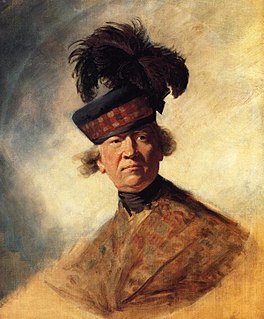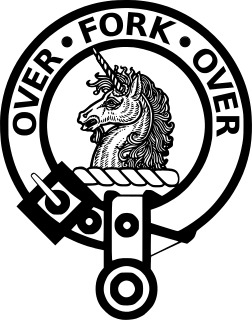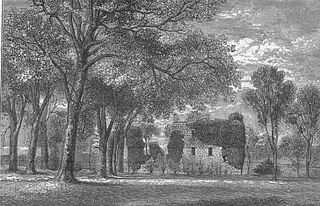John Johnstone was the 32nd Mayor of New York City from 1714 to 1719.
Beith is a small town in the Garnock Valley, North Ayrshire, Scotland approximately 20 miles south-west of Glasgow. The town is situated on the crest of a hill and was known originally as the "Hill o' Beith" after its Court Hill.

James Alexander was a lawyer and statesman in colonial New York. He served in the Colonial Assembly and as attorney general of the colony in 1721–23. His son William was later a major general in the Continental Army during the American revolution. Alexandria Township, New Jersey was named after James Alexander.
John Montgomery or Montgomerie may refer to:
James De Lancey served as chief justice, lieutenant governor, and acting colonial governor of the Province of New York.

Archibald Montgomerie, 11th Earl of Eglinton was a Scottish General and Member of Parliament (MP) in the British Parliament. He was also the Clan Chief of the Clan Montgomery. Montgomerie fought in the Seven Years' War, where he served with George Washington. He also was the patron of the poet Robert Burns.
Daniel Coxe III was an English physician and governor of West Jersey from 1687-1688 and 1689-1692.

William Burnet was a British civil servant and colonial administrator who served as governor of New York and New Jersey (1720–1728) and Massachusetts and New Hampshire (1728–1729). Born into a position of privilege, Burnet was well educated, tutored among others by Isaac Newton.

Clan Cunningham is a Scottish clan. The traditional origins of the clan are placed in the 12th century. However, the first contemporary record of the clan chiefs is in the thirteenth century. The chiefs of the Clan Cunningham supported Robert the Bruce during the Wars of Scottish Independence. In the 15th and 16th centuries, the Clan Cunningham feuded with the Clan Montgomery. Historically, the chief of Clan Cunningham held the title of Earl of Glencairn. However, in modern times the chief of the clan is Cunningham of Corsehill. On 18 December 2013, Sir John Christopher Foggo Montgomery Cunninghame, Baronet of Corsehill, was recognized by Lord Lyon as Clan Chief after the chiefship had been vacant for over 200 years.

Hessilhead is in Beith, North Ayrshire, Scotland. Hessilhead used to be called Hazlehead or Hasslehead. The lands were part of the Lordship of Giffen, and the Barony of Hessilhead, within the Baillerie of Cunninghame and the Parish of Beith. The castle was situated at grid reference NS380532.

Kilwinning Abbey is a ruined abbey located in the centre of the town of Kilwinning, North Ayrshire.

General Staats Long Morris was a British Army officer and politician who sat in the House of Commons from 1774 to 1784, representing Elgin Burghs, and served as governor of Quebec from 1797 until his death in office. Born in British North America, Morris parlayed a marriage to a Scottish noblewoman into a successful career in Britain as a military officer and politician in the British Parliament.

The Barony of Giffen and its associated 15th-century castle were in the parish of Beith in the former District of Cunninghame, now North Ayrshire. The site may be spelled Giffen or Giffin and lay within the Lordship of Giffin, which included the Baronies of Giffen, Trearne, Hessilhead, Broadstone, Roughwood and Ramshead; valued at £3,788 9s 10d. The Barony of Giffen comprised a number of properties, including Greenhills, Thirdpart, Drumbuie, Nettlehirst and Balgray, covering about half of the parish of Beith. Giffen was a hundred merk land, separated from the Barony of Beith, a forty-pound land, by the Powgree Burn which rises on Cuff hill. The Lugton Water or the Bungle Burn running through Burnhouse may have been the Giffen barony boundary with that of the adjacent barony and lands of Aiket castle.

Spier's School, at Beith, in North Ayrshire, Scotland was opened in 1888 and closed in 1972. The school, now demolished, was built using Ballochmyle red sandstone and was reminiscent of the ancient Glasgow University. The school motto was 'Quod verum tutum'. The gardens and woodlands are open to the public at all times.

Broadstone lies close to the small village of Gateside in North Ayrshire, Scotland about half a mile east of Beith in the old Barony of Giffen.
The history of Albany, New York from 1664 to 1784 begins with the English takeover of New Netherland and ends with the ratification of the Treaty of Paris by the Congress of the Confederation in 1784, ending the Revolutionary War.

The remains of the old castle of Kersland lie about 1.5 miles to the north-east of the town of Dalry in North Ayrshire, Scotland, in the old Barony of Kersland. The River Garnock lies nearby.
The Lands of Doura, Dawra, Dawray, DowreyDowray, Dourey or Douray formed a small estate, at one time part of the Barony of Corsehill and Doura, situated near the Eglinton Estate in the Parish of Kilwinning, North Ayrshire, Scotland.

The ancient lands of Willowyard, Willieyeards, Williyard or Willizeards were part of the holdings of the Regality of Kilwinning, Barony of Beith, and Bailiary of Cuninghame. They later became the property of the Montgomerie family before being sold to the Simson family in 1723. The manor house still survives as part of a business premises and the nearby industrial estate and whisky bond carry the name 'Willowyards'.

Coldstream Mill, near Beith in North Ayrshire, Scotland was an early 19th century meal mill powered by the Dusk Water and Whitestone Burn that was enlarged from an existing much earlier watermill. The mill worked until 1991 and was the last traditional working water mill in Ayrshire and one of the last continuously worked watermills in Scotland. The mill buildings have been converted into a private dwelling and the mill pond has been retained.













